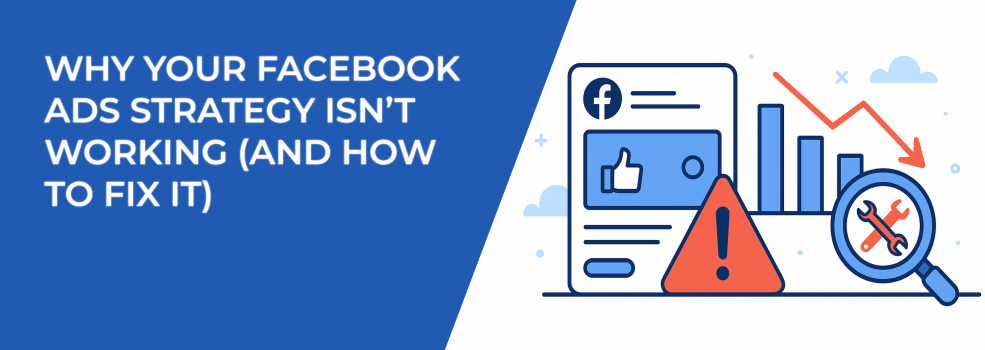You’re running ads on Facebook and Instagram. Maybe you’ve tried different audiences, tested new creative, adjusted your copy, and followed all the best practices. But something still feels off.
You’re spending money and not seeing enough back.
Here’s the thing: most underperforming campaigns aren’t failing because of bad copy or wrong interests. They’re failing because the strategy behind them is misaligned.
In this article, we’ll break down the real reasons Facebook ad strategies fall short — and what you need to rebuild a system that actually drives results.
The Problem: You’re Focusing on Tactics, Not Strategy
A lot of advertisers start with execution. They think: “What’s the best creative to run?” or “Which lookalike audience should I use?” Those are important questions — but they’re not the first ones you should ask.
Effective Facebook advertising starts with strategic clarity. Who are you trying to reach? What are they thinking? What is their intent? Where are they in your customer journey? And how does your offer actually solve a problem for them?
If you’re trying to sell a $500 product to a cold audience with a static image and a “Buy Now” button, the problem isn’t the ad format. The problem is that you skipped over strategy and jumped straight to the sale.
Fix it by stepping back:
-
Define your customer journey. What needs to happen before someone is ready to buy?
-
Align your campaigns with intent. Are you running awareness ads for people who’ve never heard of you, or just pushing hard offers to everyone?
-
Understand why people buy, not just who they are. Your targeting should reflect behavior, not just demographics.
Without this strategic foundation, your ads are just noise no matter how well-crafted they are.
Your Offer Doesn’t Match Market Maturity
One of the most overlooked parts of a Facebook ads strategy? The offer itself.
You could have the best targeting and creative in the world — but if your offer doesn’t match where the market is, it won’t convert.
Let’s say you’re advertising a brand-new product or service that people haven’t seen before. That’s a “cold” market — they don’t know you, and they don’t know they have a problem yet. In that case, asking for a purchase right away is too much. You’ll need to educate them first, possibly over several touchpoints.
Now flip that: if you’re in a competitive niche where users are already comparison-shopping, then clarity and urgency are key. They’re not browsing. They’re choosing. And your offer needs to stand out fast.
Ask yourself:
-
Does your audience already understand the problem you solve?
-
Do they believe your solution is better than others?
-
Are you offering something easy to say yes to, especially on a first touch?
If not, rethink the structure of your funnel. In many cases, poor ad performance is really a sign that your offer or messaging is out of sync with your audience’s current level of awareness.
You’re Optimizing for the Wrong Metrics
Let’s talk about the backend of your strategy.
Most advertisers track click-through rate, cost per click, and sometimes ROAS. But those metrics only tell part of the story — and if you’re optimizing for them in isolation, you can end up scaling campaigns that don’t actually help your business.
Real strategic insight comes from looking deeper:
-
Are you attracting the right leads or buyers, or just cheap traffic?
-
How long does it take for a user to convert, and are you measuring the full journey?
-
Are your top-of-funnel campaigns supporting bottom-of-funnel performance?
For example, if you’re running video view campaigns to warm up your audience, but not retargeting them effectively afterward, you're leaving value on the table. Or if you're getting leads from a quiz funnel but 90% of them never convert, that's a lead quality issue, not a creative issue.
Fix it by re-aligning your goals and measurement:
-
Segment performance by funnel stage.
-
Connect ad data with CRM or backend purchase data.
-
Focus on customer acquisition cost, not just cost per result.
You can’t improve what you don’t understand, and Facebook Ads Manager alone won’t tell you the whole story. Here’s how to define custom performance metrics that better reflect your real campaign goals.
Your Funnel Isn’t Built for Paid Traffic
Another reason your Facebook ads aren’t working? You’re sending paid traffic into a funnel that wasn’t designed to convert cold users.
A common example: running ads to a homepage. It may look good, but it’s usually too generic to convert well. Or sending people to a product page without any context, testimonials, or offer. Or using email opt-ins with no post-signup nurture.
Paid traffic needs structure:
-
A clear entry point (ad).
-
A tightly aligned landing page.
-
A low-friction first step (lead magnet, low-ticket offer, free trial).
-
A follow-up system (email sequence, retargeting, content).
If you're running Facebook ads without a funnel that supports decision-making, you’re forcing people to figure things out on their own — and most won’t.
Refine your funnel for paid traffic by:
-
Creating dedicated landing pages for each campaign.
-
Matching the ad’s promise directly with the landing page content.
-
Building retargeting sequences that respond to behavior — not just time.
Paid traffic needs direction — and a well-structured funnel makes all the difference. Here's how to build a lead magnet funnel specifically for Facebook ads that moves cold users toward conversion.
You’re Scaling Too Soon (Or Not Scaling at All)
Even well-structured strategies fail when scaling is rushed — or avoided completely.
Some advertisers try to scale early winners by simply raising the budget. Others keep testing without ever committing to a working structure. Both can tank performance.
Strategic scaling requires system thinking:
-
Are you feeding the algorithm enough consistent data?
-
Do you have a content engine to refresh creatives every 1–2 weeks?
-
Can your funnel handle 5x the volume without breaking?
Scaling isn’t just about increasing spend. It’s about making sure your targeting, creative, offer, and backend can all support that growth without collapsing under pressure.
If you’re not scaling at all, you might be stuck in test mode. In that case, build systems that let you go from test → validate → scale.
Final Thoughts: Strategy First, Tactics Second
Facebook ads don’t fail because the algorithm is broken. They fail because the strategy behind them is shallow, reactive, or incomplete.
Fixing your Facebook ads strategy means:
-
Understanding your customer deeply,
-
Mapping their journey and intent,
-
Creating offers that match their mindset,
-
Building funnels that convert cold traffic,
-
Measuring what actually matters,
-
Scaling with discipline.
It’s not about finding a “magic” ad. It’s about building a system where the platform can actually help you win. If your goal is predictable, sustainable growth (and not short-term hacks), take a look at our framework for building a long-term Facebook ads strategy.

